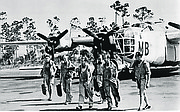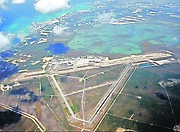NEW Providence saw over 20 World War II aircraft ditch, crash, and explode into its adjacent waters. Most of these were to the south of the island, east, and north, and depended on direction of the winds, which air field was used, and complex night-time exercises using extremely bright Leigh Lights, and flying in formation. Mechanical failures from aircraft just delivered from American factories played a role as well.
Seventy-nine persons were killed in the waters, with five known survivors. The majority of water-borne accidents were on Royal Air Force training and transport bombers, like the B-25, B-24 and B-26’es, or A-20 or A-30’s, five were operated by the US Army Air Force – one was consumed by a microburst on final approach to Windsor. Six airplanes were amphibious; PBY, PSP, PV-1, PBM, Kingfishers. Seven were with the US Navy, particularly at the Nassau Harbour ramp which became Pan Am and is now the RBDF and BASRA base downtown.
Six of the aircraft splashed out west, in Lake Killarney, Clifton Bay, or Delaport Bay. Ten of them either wrecked near or had pieces drift up in Montagu Bay, Eastern Foreshore, and Atoll Island. Three sank to the north so deeply as to be economically unsalvageable, and the balance fell out of the sky south of the capital island, off places like Yamacraw, or closer to Green Cay.
Nine, or about half, of the accidents occurred in 1943, the balance split between 1944 and 1945. Survivors include Baxter and Davids whose seaplane hit the hanger at the harbour ramp, followed by Robert Allen of the USAAF who swam away from a ditching on delivery on March 2, 1944. On 21 June that year James McLean, John Tickler, and John Vallance were lost when their RAF B-25 was lost ten miles east of Nassau.
Then the following week more staggering losses of life, when another B-25 bomber took off for training at 2.45pm. Radio communications were lost at 3.15pm, and later rescuers found an empty dinghy and oleo leg just 3.5 miles north-northwest of Old Fort Bay. No trace of survivors was found, and Beaulieu, Keayes, Ogren, Smart, Stinson, Torrens, and Wallace, were all lost. On the 9th of April 1943 ditched at sea, crashed fifteen miles southwest of Clifton Bay. Yellow Orange light found by Lyford Air Sea Rescue. A Windsor Field aircraft on exercise sighted empty dinghy. Dinghy retrieved by surface craft, empty and damaged. Twelve days later ASR boat found an aircraft dinghy. All the men: Schafer, Waton, Goodman, Fenton, Farnsworth, Tomkins, and Burchell.
More troubling and not resolved, is a case of a B-24 on 29 October 1943, which went missing between Florida and Puerto Rico. Though a life raft signal seen, it was not confirmed then amongst aircraft wreckage was found a tobacco pouch, and a shattered airplane piece; mysteriously, at about the same time four explosions were heard northeast of Green Cay. Many USAAF aircraft went missing in The Bahamas between West Palm (then Morrison Field) and Borinquen PR. The 23 December 1943 crash which claimed Frye, McLean, Wilcox, Petersen, Swire and Craig was no less frustrating, with the RAF crash boats noting it ditched in sea 6.5 miles from the New Providence airfield. Then the plane was discovered three weeks later, in just ten feet of water riddled with strong tides. There was no trace of crew. A resident on Athol Island confirmed the crash, and showed the Air Sea Rescue team parts of the disintegrated fuselage.
Later, on November 24, 1944, two bombers practising the blinding Leigh Lights against German U-Boats both collided in a dive – they essentially followed the light beams into the sea. This tragic error cost the lives of John Scammell, George Gamble, and David Strachan. Gamble was highly decorated, having sunk the German submarine U-964 the year before. On the other aircraft involved, Captain Allbut with seven other trainees they too crashed into deep ocean about 3.5 nm north of Cabbage Beach, Paradise Beach. Several other aircraft searched and located wreckage. ASR launches HMS P-89 and HMS P-181 to the scene. The vessels found a dinghy matched to the wreck, and were trying to tow a portion of the fuselage three miles or so to shore yet were unable. Prior to departing the wreck site, the ASR officers requested that a US Navy vessel destroy the remainder of the fuselage so as to avoid a hazard to navigation. No bodies were recovered.
Though without casualties, a PBY Mariner broke free of its mooring in a storm and had to be corralled back to base by boat on 11 December 1944. On April 9, 1945 Acton, Dumble, Hallett, Hutchinson, Moule, Scott, and Wild were killed when their B-25 ditched in a trail of smoke, crashed to the sea south of East Point. RAF ASR boat HMS P-2779 from Montagu was sent and the plane B-25 FY was airborne at 8.30pm to search. Two parachutes were found and later identified as issued to the crew of the missing aircraft.
Similarly, on April 21, a B-25 with Beyon, Hamlin, Hanney, Lunam, McLean, and Smith crashed into the sea while on exercises 5 miles north of New Providence. ASR boats HMS T-170 and HMS P-191 found an oil patch and an airplane dinghy which helped match the oil to the plane with the same tail number, however they were unable to find survivors.
On July 10, 1945, a flying boat of the PBM-3 design in the US Navy was lost with a crew of 12 when on a flight to Exuma over Nassau they Flt to Great Exuma, flew FL to Windsor en route Exuma, but overwhelmed by severe storm 10 nm N of NP, last reported 8 nm N or Cabbage Beach, Hog/Paradise Island. USN PBM en route Banana River (JAX) to Great Exuma never arrived, never found. “Flew into a severe storm in that area and he and his plane and crew went missing.”
Overall, the waters around Nassau and New Providence have everything researchers would want; more of them than around any other island barring perhaps Andros, access to the busiest airport in the country, the most SCUBA infrastructure, and fairly shallow waters, primarily to the south and east. In fact, two B-26 bombers have been found in these waters in less than a year, one has been salvaged post-war from Lake Killarney and no doubt more discoveries will follow. Also, the graves where the men were buried and dozens of sites relevant to WWII are still there.









Comments
Use the comment form below to begin a discussion about this content.
Sign in to comment
Or login with:
OpenID